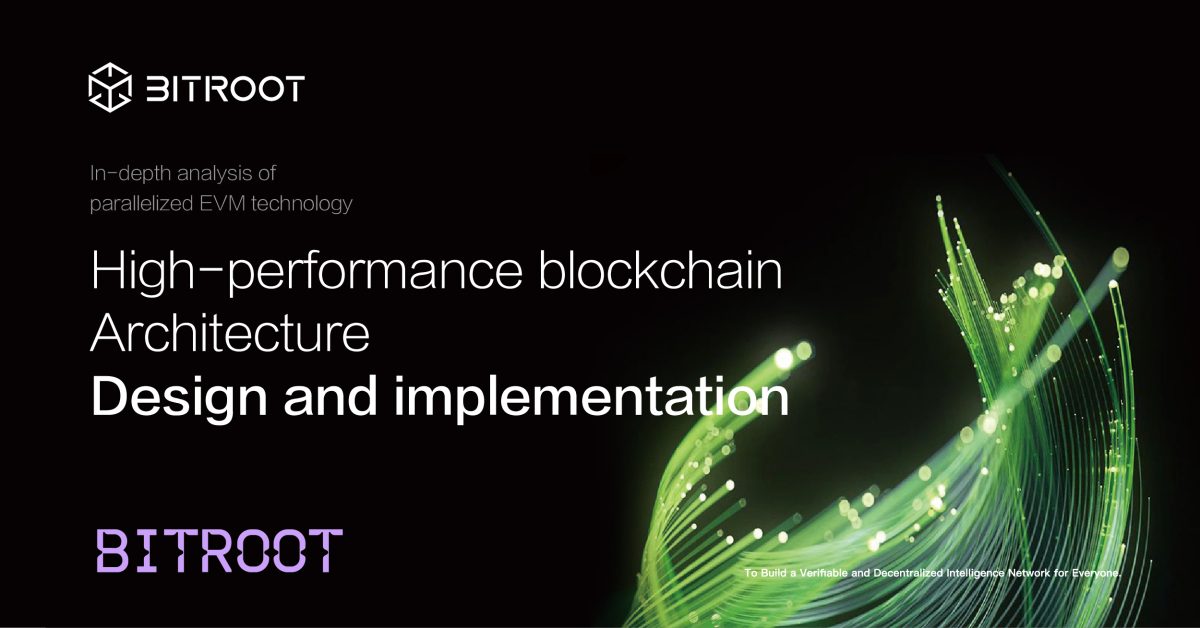Bitroot: Redefining Blockchain Performance with Parallel EVM Architecture

Over the past decade, blockchain scalability has remained the primary bottleneck preventing mass adoption. Ethereum, processing around 15 transactions per second (TPS), has long exposed the limits of serial execution models. Bitroot emerges as a new-generation Layer 1 blockchain that breaks through these constraints — achieving 100,000 TPS and 300 ms finality through a combination of Pipeline BFT consensus, optimistic parallelized EVM, state sharding, and BLS signature aggregation.
A Layered Architecture Built for Performance
Bitroot’s five-layer modular design — Storage, Network, Consensus, Protocol, and Application — ensures both scalability and maintainability.
The Storage Layer integrates distributed sharding to reduce state bloat and enable validation on ordinary hardware.
The Network Layer employs Kademlia DHT and GossipSub, optimized for large-scale data transfer.
The Consensus Layer, powered by Pipeline BFT, decouples consensus from execution — allowing new blocks to progress even before prior blocks are finalized.
The Protocol Layer introduces a parallel execution engine that remains fully EVM-compatible, supporting seamless migration for Ethereum-based applications.
The Application Layer provides SDKs and standardized interfaces for rapid DApp development.
This modularity enables Bitroot to evolve rapidly without disrupting existing infrastructure — a key differentiator from monolithic blockchain designs.
Pipeline BFT: Consensus at Assembly-Line Speed
Traditional BFT systems, such as Tendermint, are constrained by serialized block confirmation and high communication complexity (O(n²)). Bitroot’s Pipeline BFT reimagines consensus as a four-stage assembly line — Propose, Prevote, Precommit, and Commit — allowing multiple blocks to be processed concurrently.
This pipelined mechanism, combined with BLS signature aggregation, reduces confirmation latency to 300 milliseconds and compresses signature verification from O(n) to O(1). By decoupling consensus from execution and enabling batching, Bitroot achieves industry-leading scalability without sacrificing decentralization.
Optimistic Parallelized EVM: Unlocking Multicore Potential
Bitroot’s Optimistic Parallelized EVM (OPEVM) eliminates the single-threaded limitations of traditional EVMs.
It introduces a three-stage conflict detection system — pre-execution static analysis, in-execution dynamic monitoring, and post-execution global verification — ensuring both safety and efficiency under high concurrency.
Through smart transaction grouping, fine-grained read/write locks, and NUMA-aware scheduling, Bitroot maintains optimal CPU utilization (90%) and achieves up to 7–12× higher throughput compared to Ethereum’s serial EVM.
The result: deterministic parallelism without compromising correctness — a critical step toward AI-compatible blockchain computation.
State Sharding: True Horizontal Scalability
To support exponential growth, Bitroot implements state sharding by distributing account states across multiple shards. Each shard maintains an independent state tree, while a shard coordinator ensures atomicity and consistency via a two-phase commit protocol.
This design allows linear scalability — as the number of shards increases, throughput scales proportionally — providing a sustainable path for long-term growth.
Performance Validation and Ecosystem Integration
Benchmark testing on AWS infrastructure demonstrated 25,600 TPS, 1.2-second total latency, and 85% resource utilization, outperforming comparable Layer 1 networks by over 50×. Gas fees are reduced by up to 90%, positioning Bitroot as a practical alternative to Layer 2 solutions while retaining full decentralization.
Bitroot’s EVM compatibility allows developers to migrate Ethereum applications seamlessly — accelerating adoption across DeFi, NFT, gaming, and enterprise applications. Its upcoming AI integration framework further expands possibilities, enabling decentralized AI agents and on-chain machine learning models.
Conclusion: The Infrastructure for the Intelligent Web3 Era
Bitroot represents a major leap forward in blockchain engineering — transforming academic research into real-world performance.
By combining Pipeline BFT, Optimistic Parallelized EVM, and State Sharding, Bitroot provides a complete blueprint for high-performance blockchain systems.
It not only bridges the gap between performance and decentralization, but also lays the technical foundation for the convergence of AI and Web3.
As the demand for intelligent, scalable, and interoperable infrastructure grows, Bitroot stands ready to power the next generation of decentralized applications — from real-time finance to AI-driven ecosystems.
Disclaimer: The content of this article solely reflects the author's opinion and does not represent the platform in any capacity. This article is not intended to serve as a reference for making investment decisions.
You may also like
$8.8 billion outflow countdown: MSTR is becoming the abandoned child of global index funds
The final result will be revealed on January 15, 2026, and the market has already started to vote with its feet.

Deconstructing DAT: Beyond mNAV, How to Identify "Real vs. Fake HODLing"?
There is only one iron rule for investing in DAT: ignore premium bubbles and only invest in those with a genuine flywheel of continuously increasing "crypto per share."

Empowered by AI Avatars, How Does TwinX Create Immersive Interaction and a Value Closed Loop?
1. **Challenges in the Creator Economy**: Web2 content platforms suffer from issues such as opaque algorithms, non-transparent distribution, unclear commission rates, and high costs for fan migration, making it difficult for creators to control their own data and earnings. 2. **Integration of AI and Web3**: The development of AI technology, especially AI Avatar technology, combined with Web3's exploration of the creator economy, offers new solutions aimed at breaking the control of centralized platforms and reconstructing content production and value distribution. 3. **Positioning of the TwinX Platform**: TwinX is an AI-driven Web3 short video social platform that aims to reconstruct content, interaction, and value distribution through AI avatars, immersive interactions, and a decentralized value system, enabling creators to own their data and income. 4. **Core Features of TwinX**: These include AI avatar technology, which allows creators to generate a learnable, configurable, and sustainably operable "second persona", as well as a closed-loop commercialization pathway that integrates content creation, interaction, and monetization. 5. **Web3 Characteristics**: TwinX embodies the assetization and co-governance features of Web3. It utilizes blockchain to confirm and record interactive behaviors, turning user activities into traceable assets, and enables participants to engage in platform governance through tokens, thus integrating the creator economy with community governance.

Aster CEO explains in detail the vision of Aster privacy L1 chain, reshaping the decentralized trading experience
Aster is set to launch a privacy-focused Layer 1 (L1) public chain, along with detailed plans for token empowerment, global market expansion, and liquidity strategies.

